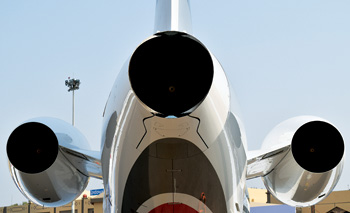INDIAN ARMED FORCES CHIEFS ON
OUR RELENTLESS AND FOCUSED PUBLISHING EFFORTS

SP Guide Publications puts forth a well compiled articulation of issues, pursuits and accomplishments of the Indian Army, over the years

I am confident that SP Guide Publications would continue to inform, inspire and influence.

My compliments to SP Guide Publications for informative and credible reportage on contemporary aerospace issues over the past six decades.
Before You Put a Business Jet on Your Company Radar, Know Your 4-Cs
 | By Simon Davies Sales Director, Global Jet Capital |
Why are more Indian companies choosing to fly private aircraft? As you can imagine, the benefits are numerous. Think of them as the four “Cs”:
- comfort,
- convenience,
- capacity and
- cost-efficiency.
The fact that flying private offers unmatched comfort compared to the commercial alternative goes without saying. But there is also greater convenience for you, your team members and above all—your clients. Greater privacy and less hassles: no airport crowds, no lost luggage, and fewer flight cancellations or delays. Business aircraft deliver a measurable increase in your organization’s overall capacity. It’s simply the capability to extend or expand your business in places you never thought possible and the opportunity for you and your staff to get more done in less time, while exceeding client demands.
Of course, the more elusive fourth C is perhaps the most challenging for C-level managers to realize. Cost-efficiency. It isn’t a term one associates with operating business aircraft. However, there is one reason why it should be: Operating Leases.

Operating leases are an increasingly popular financing tool that allows business aircraft users to gain access to private aircraft. In an operating lease financing structure, you can: enter into a sale and leaseback arrangement for your pre-owned jet; identify a jet to purchase; or assign your purchase contracts to your new, on-order jet. And, in each of these scenarios, you do not take ownership of the aircraft, but have full use of it as if you do. This means your crew, your pilot and your flight path; with less risk, more freed up capital and the ability to change aircraft easily at the end of lease.
Using traditional loan financing represents a significant allocation of capital into a depreciating asset. However, with an operating lease, up to 100% of the aircraft’s market value can be funded. Clients typically only have to fund the security deposit, import duties and VAT (Value Added Tax), and certain other transaction costs at closing. This allows high net worth individuals and corporations the opportunity to gain access to a long-range jet without having to tie up significant amounts of capital in a non-core asset. Further, importing an aircraft into India on an operating lease can significantly reduce the impact of taxes and duties applicable to the aircraft, ultimately saving you money.
SHIFT THE RISK
Operating leases shift the risk of ownership to the lessor and away from the lessee. At the end of the operating lease, the customer simply returns the aircraft. The value of the asset at the end of the lease is the lessor’s issue, not the customer’s. Other factors that can go into making an operating lease more attractive are things like a slump in global equity markets, or an excess supply of pre-owned aircraft. All affect the future value of private aircraft, but with an operating lease the customer has no exposure to any of these events.
At the end of the loan term, when it comes time to sell your aircraft, cost of ownership can jump if you end up not being able to sell in a timely manner, or if the net proceeds fall short of your ideal expectations. With an operating lease, there is a shift of the residual value risk to the lender, which provides the customer with a certainty of cost associated with the term of use for an aircraft. In short, you know what you are getting into and eventually, getting out of.
Along with allocation of capital, no residual value risk and certainty of cost, you get an additional benefit with an operation lease – flexibility. If you are interested in moving into a different aircraft model at the end of your lease, an operating lease model allows for this seamlessly. You can upgrade to the latest technology aircraft, adjust the size or capabilities of it to reflect a changing mission profile, or seek to extend the lease on your current aircraft.
In India, the trend towards operating leases is growing because it’s simply more efficient to lease an aircraft than to buy one. Operating leases also allow you to reduce the complexity of typical regulations that can make purchasing aircraft more of a challenge in certain regions.
So, now that you know your 4Cs of business aircraft operation: comfort, convenience, capacity and cost-efficiency with the advantages of an operating lease, private aircraft ownership for your enterprise in India is less elusive than first thought.





